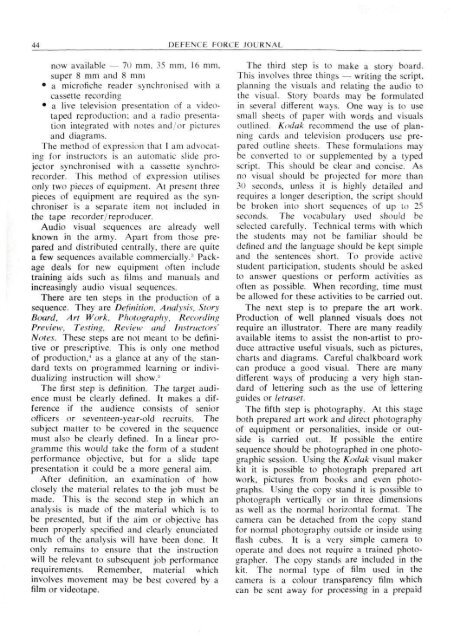ISSUE 3 : Mar/Apr - 1977 - Australian Defence Force Journal
ISSUE 3 : Mar/Apr - 1977 - Australian Defence Force Journal
ISSUE 3 : Mar/Apr - 1977 - Australian Defence Force Journal
You also want an ePaper? Increase the reach of your titles
YUMPU automatically turns print PDFs into web optimized ePapers that Google loves.
44 DEFENCE FORCE JOURNALnow available — 70 mm. 35 mm, 16 mm.super 8 mm and 8 mm• a microfiche reader synchronised with acassette recording• a live television presentation of a videotapedreproduction: and a radio presentationintegrated with notes and/or picturesand diagrams.The method of expression that I am advocatingfor instructors is an automatic slide projectorsynchronised with a cassette synchrorecorder.This method of expression utilisesonly two pieces of equipment. At present threepieces of equipment are required as the synchroniseris a separate item not included inthe tape recorder/reproducer.Audio visual sequences are already wellknown in the army. Apart from those preparedand distributed centrally, there are quitea few sequences available commercially. 1 ' Packagedeals for new equipment often includetraining aids such as films and manuals andincreasingly audio visual sequences.There are ten steps in the production of asequence. They are Definition, Analysis, StoryBoard, Art Work, Photography, RecordingPreview, Testing, Review and Instructors'Notes. These steps are not meant to be definitiveor prescriptive. This is only one methodof production,' as a glance at any of the standardtexts on programmed learning or individualizinginstruction will show."'The first step is definition. The target audiencemust be clearly defined. It makes a differenceif the audience consists of seniorofficers or seventeen-year-old recruits. Thesubject matter to be covered in the sequencemust also be clearly defined. In a linear programmethis would take the form of a studentperformance objective, but for a slide tapepresentation it could be a more general aim.After definition, an examination of howclosely the material relates to the job must bemade. This is the second step in which ananalysis is made of the material which is tobe presented, but if the aim or objective hasbeen properly specified and clearly enunciatedmuch of the analysis will have been done. Itonly remains to ensure that the instructionwill be relevant to subsequent job performancerequirements. Remember, material whichinvolves movement may be best covered by afilm or videotape.The third step is to make a story board.This involves three things — writing the script,planning the visuals and relating the audio tothe visual. Story boards may be formulatedin several different ways. One way is to usesmall sheets of paper with words and visualsoutlined. Kodak recommend the use of planningcards and television producers use preparedoutline sheets. These formulations maybe converted to or supplemented by a typedscript. This should be clear and concise. Asno visual should be projected for more than30 seconds, unless it is highly detailed andrequires a longer description, the script shouldbe broken into short sequences of up to 25seconds. The vocabulary used should beselected carefully. Technical terms with whichthe students may not be familiar should bedefined and the language should be kept simpleand the sentences short. To provide activestudent participation, students should be askedto answer questions or perform activities asoften as possible. When recording, time mustbe allowed for these activities to be carried out.The next step is to prepare the art work.Production of well planned visuals does notrequire an illustrator. There are many readilyavailable items to assist the non-artist to produceattractive useful visuals, such as pictures,charts and diagrams. Careful chalkboard workcan produce a good visual. There are manydifferentways of producing a very high standardof lettering such as the use of letteringguides or letraset.The fifth step is photography. At this stageboth prepared art work and direct photographyof equipment or personalities, inside or outsideis carried out. If possible the entiresequence should be photographed in one photographicsession. Using the Kodak visual makerkit it is possible to photograph prepared artwork, pictures from books and even photographs.Using the copy stand it is possible tophotograph vertically or in three dimensionsas well as the normal horizontal format. Thecamera can be detached from the copy standfor normal photography outside or inside usingflash cubes. It is a very simple camera tooperate and does not require a trained photographer.The copy stands are included in thekit. The normal type of film used in thecamera is a colour transparency film whichcan be sent away for processing in a prepaid
















